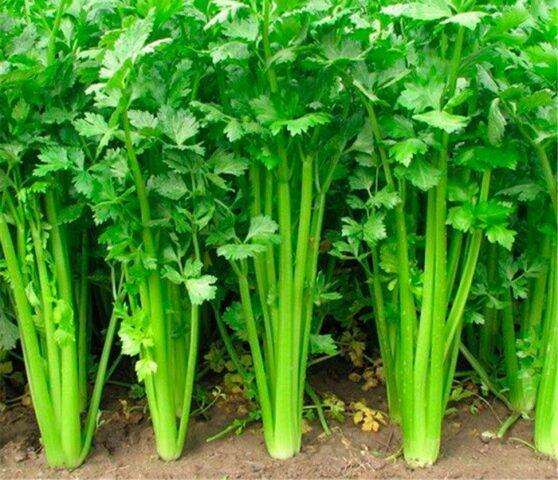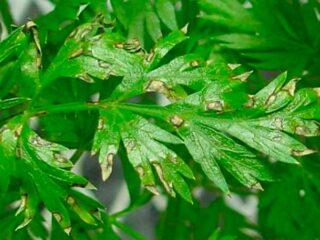Content
Herbs similar to parsley include cilantro, celery, lovage and some others. We are mainly talking about crops that belong to the same Umbrella family. They resemble parsley in appearance, but often have a different aroma and taste. It is worth considering that there are also poisonous representatives that are very dangerous to health and can even be fatal.
A plant similar to parsley with a scent
Many fragrant plants resemble parsley. Among them there are mainly edible varieties, but there are also poisonous representatives:
- Cilantro is very similar in appearance to parsley - so in the store it is extremely difficult to distinguish them. Has a characteristic aroma; if you look closely, you will notice that the leaves are smaller.
- Celery has a spicy smell. It is used fresh in salads and heat-treated - in sauces and soups. It is served with main courses. Unlike parsley, it produces a powerful stem and a rounded root crop.
- Lovage is another edible herb with a strong celery scent.Used for preparing various dishes, including confectionery and drinks.
- Common chervil is somewhat similar to parsley leaves and gives a pronounced anise aroma. Used for various dishes, added at the end of cooking. It tastes like parsnips.
- Vekh poisonous smells like carrots, the rhizome tastes like rutabaga. Extremely dangerous - just 100 g of roots can kill an adult cow. When poisoned, a person experiences severe vomiting and foam at the mouth. It is necessary to perform gastric lavage as quickly as possible, otherwise there is a risk of death.
- Omezhnik water gives a pleasant smell. It is used as a seasoning for various dishes. Outwardly, it resembles saffron saffron, which is extremely poisonous. Therefore, it is not worth collecting such plants.
Herbs similar to parsley
There are several spices similar to parsley. It is most easily confused with cilantro. There is an even less similar plant - lovage, which is also used in cooking.
Cilantro
Cilantro is a plant with leaves very similar to parsley. They are similar in appearance, and at first glance they are the same herb. But the leaves of cilantro are more delicate to the touch and are smaller in size. You can also distinguish it by its characteristic aroma if you mash the stem (parsley does not have such a smell).

Cilantro leaves are smaller
If you grow plants, you can distinguish them in the second year. Cilantro produces round-shaped seeds, and they are larger than parsley. The stem of this herb produces fewer leaves and the flowers are pink in color. Cilantro can also be described as a herb that is similar to parsley, but when it blooms it smells like bugs.
Celery
Celery has pinnately dissected leaves. This is another spice similar to parsley.The stem is branched and tall, grows up to 1 m. The roots are very thick, spherical (parsley root vegetables resemble carrots, only they are painted white).
The herb celery is common in culture. It is grown as an annual and biennial plant.

Both the leaves and stems and the roots themselves are used for food.
The roots have a spicy aroma and interesting taste, so they are used as a seasoning in salads, soups and other dishes.
Lovage
Among the spices similar to parsley, lovage can also be mentioned. It is called love potion, love potion, love-grass and love potion. Originated from Iran and Afghanistan, but is cultivated everywhere.
Unlike parsley, this herb produces a large stem up to 2 m high. It branches at the top. The roots are well developed and thick. The leaves are large and glossy. In this way they are not like parsley - its foliage is small and matte. Lovage leaves have an obovate or diamond-shaped shape. The flowers are small, yellow in color.
Lovage is also unlike parsley in that it produces a strong celery scent. It tastes sharper, spicy, with a bitter-salty tint. The fresh herb is often used in confectionery, marinades and drinks. Leaves and stems are used for preparing salads, green oil, and for meat and fish dishes.

Herbs are added to side dishes, soups and sauces
Weed similar to parsley
A weed similar to parsley is called common cory. It has several popular names:
- dog or poison parsley;
- chervil of a fool or fool.
The grass is one- or two-year-old, has an empty stem that branches well and grows to 80-100 cm.The leaves are similar to parsley in that they also have a deeply feathery shape, resembling a triangle in outline. The lobes are incised, the leaf blades themselves are diamond-shaped.

It is better not to eat the kokorysh
The plant has virtually no odor. There is a waxy coating on the leaves of the cory. You can find the weed everywhere, especially in vacant lots, near houses, in dachas and gardens.
A wild plant similar to parsley
On lawns, edges, fields, and near forest swamps, wild grass is found, which also looks like parsley. We are talking about creeping buttercup from the family of the same name. It often grows not only in the wilderness, but also in dachas.

Buttercup prefers damp places, so it grows well in low-lying areas
The plant is perennial. It is similar in its lower leaves, which have a trifoliate shape. In this case, the upper foliage is elongated and fits tightly to the stem (without petioles). The stems are thick, spread along the ground, and taste juicy. They have thickened internodes, which makes them different from parsley. The flowers reach 3 cm in diameter, have a regular shape (5 petals), and are bright yellow in color. They can grow singly or grouped into small inflorescences.
In small quantities it is not dangerous, but if you eat too much of this herb, severe poisoning will occur (including in pets).
Poisonous plant similar to parsley
There is also a dangerous poisonous herb similar to parsley - this is a milestone. Among the people, it has quite a few common names - it is called:
- Omezhnik;
- hemlock;
- hemlock;
- cat parsley;
- angelica;
- red head;
- water rabies;
- muddy.
Vekh grass is in many ways reminiscent of parsley leaves - they are pinnately dissected and bright green in color. But the stems are thicker and have a reddish color in the root zone. The root is powerful and very different from parsley in appearance and tastes like rutabaga. The smell is reminiscent of carrots.
You need to be very careful with the milestone - all parts of this plant are poisonous, especially the rhizome. So, 100 g is enough to kill a cow. The main signs of poisoning are vomiting, foam at the mouth, muscle spasms, and dilated pupils.

Weh is very toxic
House plant similar to parsley
There is also a domestic plant similar to parsley - it is called common chervil. This is an annual herb that produces rather elongated, oblong leaves. It grows in the Caucasus, Central Asia, as well as in the southern regions of Russia. Also called zhurnitsa, kuprem and snedok.
The herb is only vaguely similar to parsley, but it also has dissected leaves. Edible, eaten as a main or additional seasoning. It goes well with various herbs and enhances flavors. It gives off an aniseed smell and tastes more like parsnips. When preparing dishes, chervil is added at the very end; in this regard, it is also similar to parsley. This is necessary to preserve the aroma.
A killer herb similar to parsley
Among the plants similar to parsley, there is also a killer herb, the name of which is saffron saffron (shown in the photo). It grows on the coasts of swamps in the countries of Eurasia and Africa.It is a herbaceous biennial plant reaching a height of more than 1 meter. It has a characteristic structure of inflorescences, for which it received the popular name “dead man’s fingers”.
Omezhnik is toxic and can poison both people and animals. The main symptoms are vomiting, hallucinations, involuntary muscle contractions, including those on the face; in rare cases, death is possible.

Blooming saffron saffron
It is sometimes used as an aromatic spice. But inexperienced lovers may confuse it with a poisonous representative, so if you are not sure, it is definitely not worth the risk.
By what signs can you distinguish parsley?
Parsley is an edible, herb plant from the Apiaceae family. It has a cylindrical tap root and twice or thrice dissected leaves of bright green color. External features:
- flowers are small, yellow-green or light green;
- grow at the ends of peduncles, organized into small inflorescences belonging to the type of complex umbrellas;
- the fruits are gray-green, often with a brown tint, small, up to 5 mm long;
- characteristic smell;
- spicy taste.
In the first year, the plants form a rosette with leaves, and in the second - a stem. It is erect, branches well, produces flower stalks, and reaches a height of 30 to 100 cm.
Conclusion
An herb similar to parsley usually belongs to the same family. These are cilantro, lovage, common chervil and others. They are used as spices in the preparation of sauces, soups, drinks and even in confectionery. You should not confuse common vekh, saffron saffron and other poisonous herbs with parsley.














